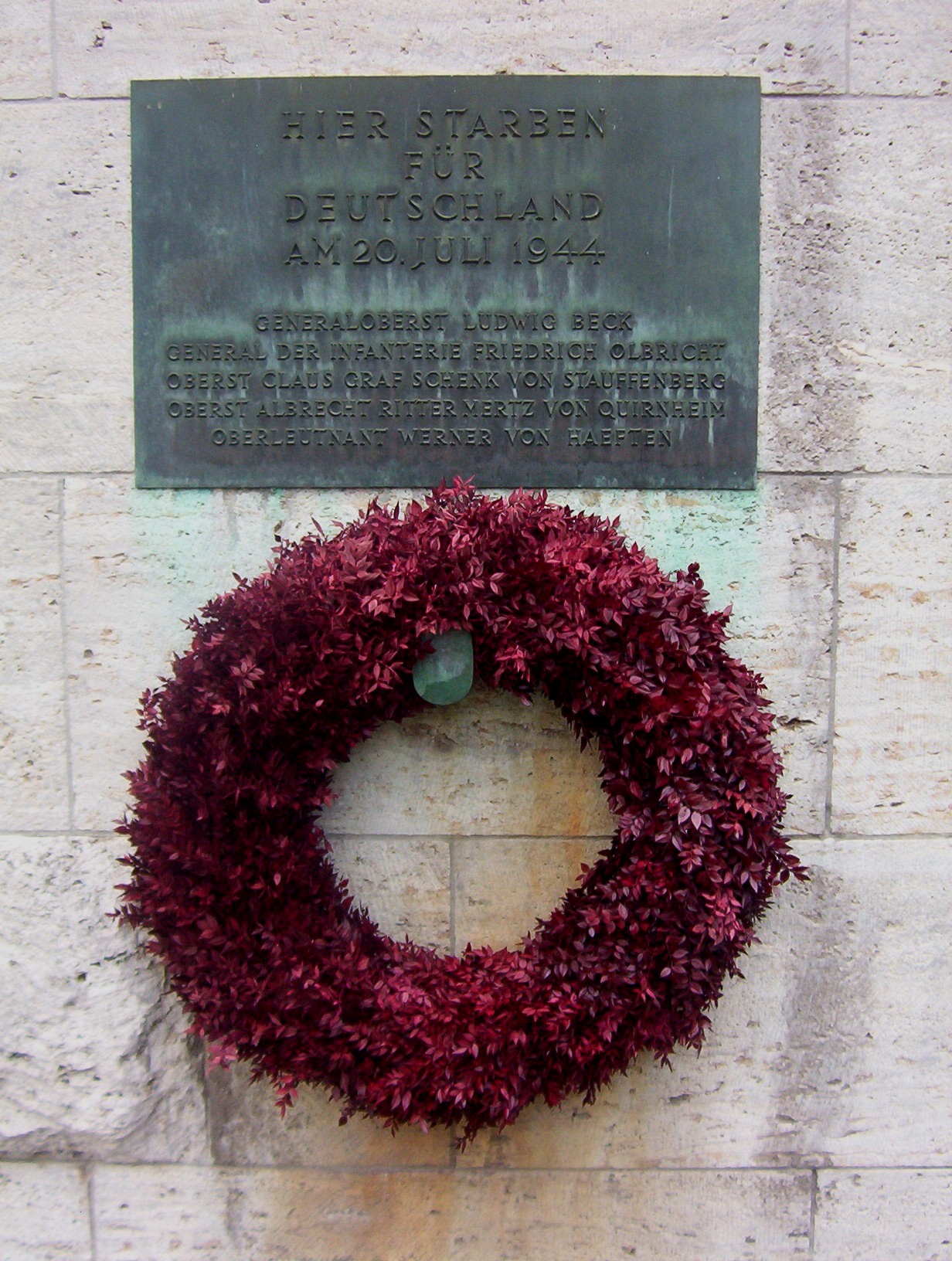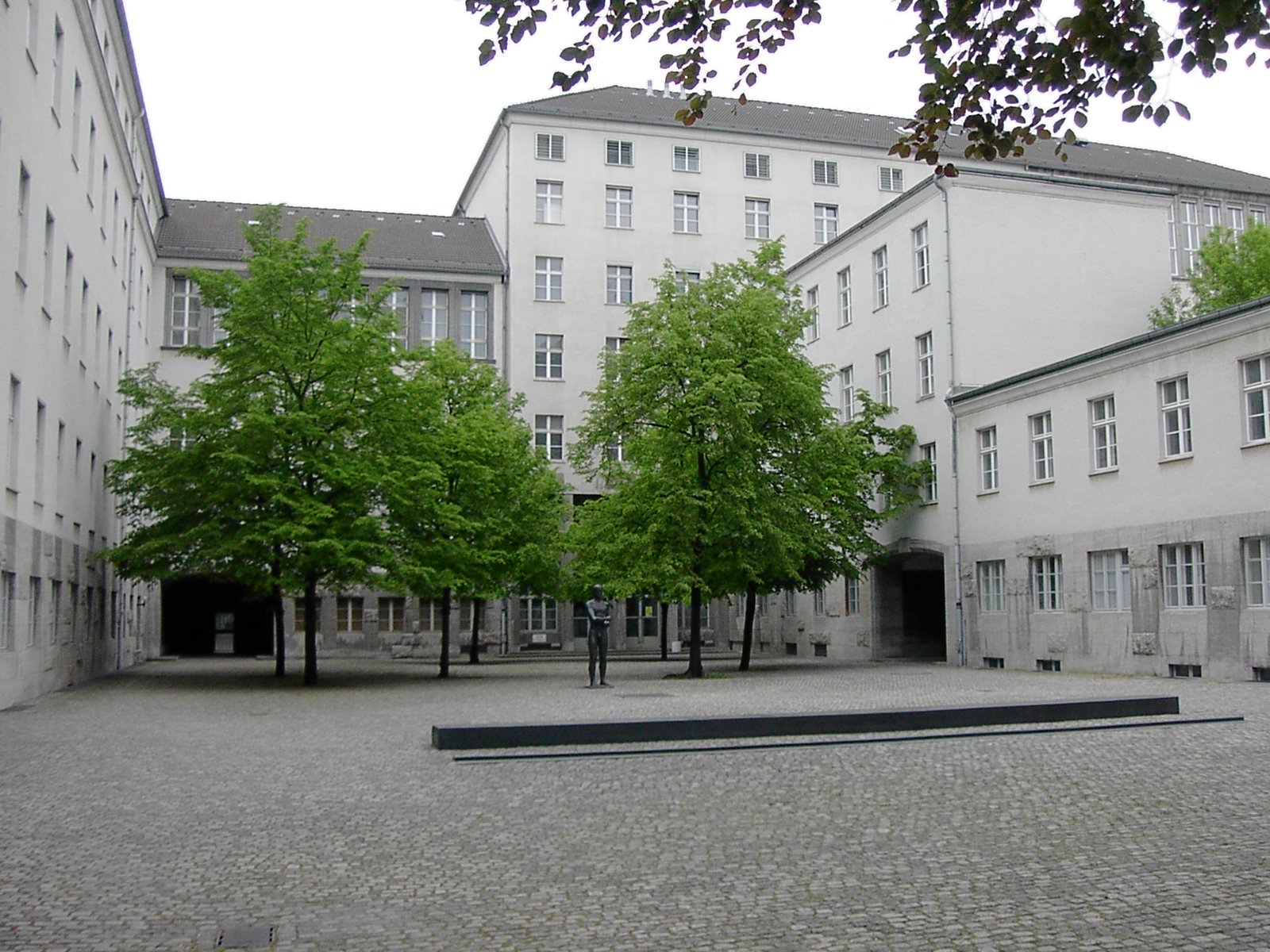|
Bendlerblock
The Bendlerblock is a building complex in the Tiergarten district of Berlin, Germany, located on Stauffenbergstraße (formerly named ''Bendlerstraße''). Erected in 1914 as headquarters of several Imperial German Navy (''Kaiserliche Marine'') offices, it served the Ministry of the Reichswehr after World War I. Significantly enlarged under Nazi rule, it was used by several departments of the '' Oberkommando der Wehrmacht'' (OKW) from 1938, especially the ''Oberkommando des Heeres'' and the '' Abwehr'' intelligence agency. The building is notable as the headquarters of a resistance band of Wehrmacht officers who staged the 20 July plot against Adolf Hitler in 1944. As the leaders of the conspiracy were summarily shot in the courtyard, the Bendlerblock also includes the Memorial to the German Resistance. Since 1993, the building complex has served as a secondary seat of the German Federal Ministry of Defence. Name The complex got its name from the street it was on. Today, it is ... [...More Info...] [...Related Items...] OR: [Wikipedia] [Google] [Baidu] |
20 July Plot
On 20 July 1944, Claus von Stauffenberg and other conspirators attempted to assassinate Adolf Hitler, Führer of Nazi Germany, inside his Wolf's Lair field headquarters near Rastenburg, East Prussia, now Kętrzyn, in present-day Poland. The name "Operation Valkyrie"—originally referring to part of the conspiracy—has become associated with the entire event. The apparent aim of the assassination attempt was to wrest political control of Germany and its armed forces from the Nazi Party (including the SS) and to make peace with the Western Allies of World War II, Allies as soon as possible. The details of the conspirators' peace initiatives remain unknown, but they would have included unrealistic demands for the confirmation of Germany's extensive annexations of European territory. The plot was the culmination of efforts by several groups in the German resistance to Nazism, German resistance to overthrow the Nazi German government. The failure of the assassination attempt an ... [...More Info...] [...Related Items...] OR: [Wikipedia] [Google] [Baidu] |
German Resistance To Nazism
Many individuals and groups in Germany that were opposed to the Nazi Germany, Nazi regime engaged in active resistance, including assassination attempts on Adolf Hitler, attempts to remove Adolf Hitler from power by assassination or by overthrowing his established regime. German resistance was not recognized as a collective united resistance movement during the height of Nazi Germany, unlike the more coordinated efforts in other countries, such as Italian Resistance, Italy, Denmark, the Soviet partisans, Soviet Union, Polish Underground State, Poland, Greek Resistance, Greece, Yugoslav Partisans, Yugoslavia, French Resistance, France, Dutch resistance, the Netherlands, Resistance in the Protectorate of Bohemia and Moravia, Czechoslovakia and Norwegian resistance movement, Norway. The German resistance consisted of small, isolated groups that were unable to mobilize widespread political opposition. Individual attacks on Nazi authority, sabotage, and the successful disclosure of ... [...More Info...] [...Related Items...] OR: [Wikipedia] [Google] [Baidu] |
Claus Von Stauffenberg
Colonel Claus Philipp Maria Justinian Schenk Graf von Stauffenberg (; 15 November 1907 – 21 July 1944) was a German army officer best known for his failed attempt on 20 July 1944 to assassinate Adolf Hitler at the Wolf's Lair. Despite initial support for the Nazi Party's nationalist aspects, and a tentative opposition to democracy, Stauffenberg joined the covert resistance movement within the Wehrmacht as the war continued, opposing the criminal character of the dictatorship. Alongside Major General Henning von Tresckow and General Hans Oster, Stauffenberg was a central figure in the conspiracy against Hitler within the . Shortly following the foiled Operation Valkyrie plot, he was executed by firing squad. As a military officer from a noble background, Stauffenberg took part in the Invasion of Poland, the 1941-42 Invasion of the Soviet Union in Operation Barbarossa and the Tunisian Campaign during the Second World War. Family history Stauffenberg was born in Stau ... [...More Info...] [...Related Items...] OR: [Wikipedia] [Google] [Baidu] |
Memorial To The German Resistance
The German Resistance Memorial Center (german: Gedenkstätte Deutscher Widerstand) is a memorial and museum in Berlin, capital of Germany. History It was opened in 1980 in part of the Bendlerblock, a complex of offices in Stauffenbergstrasse (formerly Bendlerstrasse), south of the Großer Tiergarten in Tiergarten. It was here that Colonel Claus Schenk Graf von Stauffenberg and other members of the failed 20 July plot that attempted to assassinate Adolf Hitler were executed. Although the memorial is primarily intended to commemorate those members of the German Army who tried to assassinate Hitler in 1944, it is also a memorial to the German resistance in the broader sense. Historians agree that there was no united, national resistance movement in Nazi Germany at any time during Hitler's years in power (1933–45). Joachim Fest describes it as "the resistance that never was." Nevertheless, the term German Resistance (''Deutscher Widerstand'') is now used to describe all ele ... [...More Info...] [...Related Items...] OR: [Wikipedia] [Google] [Baidu] |
Federal Ministry Of Defence (Germany)
The Federal Ministry of Defence (german: Bundesministerium der Verteidigung, ), abbreviated BMVg, is a top-level federal agency, headed by the Federal Minister of Defence as a member of the Cabinet of Germany. The ministry is headquartered at the Hardthöhe district in Bonn and has a second office in the ''Bendlerblock'' building in Berlin. According to Article 65a of the German Constitution (''Grundgesetz)'', the Federal Minister of Defence is Commander-in-chief of the ''Bundeswehr'', the German armed forces, with around 265,019 active soldiers and civilians. Article 115b decrees that in the state of defence, declared by the Bundestag with consent of the Bundesrat, the command in chief passes to the Chancellor. The ministry currently has approximately 3,730 employees. Of these, 3,230 work in Bonn while around 500 work in the ''Bendlerblock'' building in Berlin. Organization On April 1, 2012, the Federal Ministry of Defence (DEU MOD) changes its organization to the follow ... [...More Info...] [...Related Items...] OR: [Wikipedia] [Google] [Baidu] |
Ministry Of The Reichswehr
The Ministry of the Reichswehr or Reich Ministry of Defence (german: Reichswehrministerium) was the defence ministry of the Weimar Republic and the early Third Reich. The 1919 Weimar Constitution provided for a unified, national ministry of defence to coordinate the new ''Reichswehr'', and that ministry was set up in October 1919, from the existing Prussian War Ministry and ''Reichsmarineamt''. It was based in the Bendlerblock building. The ''Wehrgesetz'' (Defence Law) of 21 May 1935 RGBl I, S. 609 / FaksimilWehrgesetz/ref> renamed it the Reich Ministry of War (german: Reichskriegsministerium), which was then abolished in 1938 and replaced with the '' Oberkommando der Wehrmacht''. History Within the framework of the ''Gesetz über die Bildung einer vorläufigen Reichswehr'' ("Law on the formation of a provisional national defence force") of March 1919, the ''Reichspräsident'' was commander-in-chief of the armed forces, with the ''Reichswehrminister'' (Reich Minister of Defence ... [...More Info...] [...Related Items...] OR: [Wikipedia] [Google] [Baidu] |
German Imperial Naval Office
The Imperial Naval Office (german: Reichsmarineamt) was a government agency of the German Empire. It was established in April 1889, when the German Imperial Admiralty was abolished and its duties divided among three new entities: the Imperial Naval High Command (''Kaiserliches Oberkommando der Marine''), the Imperial Naval Cabinet (''Kaiserliches Marinekabinett'') and the Imperial Naval Office performing the functions of a ministry for the Imperial German Navy. Structure and tasks According to the 1871 Constitution of the German Empire, the federal states were responsible for the German land forces and the imperial government for the navy. So while there were Prussian, Bavarian, Saxon and Württemberg armies, there was a single Imperial Navy, the only formation under the direct authority of the German Reich beside the colonial ''Schutztruppe'' forces. The head of the Naval Office was a Secretary of State who reported directly to the Imperial Chancellor (''Reichskanzler''). W ... [...More Info...] [...Related Items...] OR: [Wikipedia] [Google] [Baidu] |
Tiergarten (Berlin)
Tiergarten (, literally ''Animal Garden'', historically for ''Deer Garden'') is a locality within the borough of Mitte, in central Berlin (Germany). Notable for the great and homonymous urban park, before German reunification, it was a part of West Berlin. Until Berlin's 2001 administrative reform, Tiergarten was also the name of a borough (Bezirk), consisting of the current locality (''Ortsteil'') of Tiergarten (formerly called ''Tiergarten-Süd'') plus Hansaviertel and Moabit. A new system of road and rail tunnels runs under the park towards Berlin's main station in nearby Moabit. History Historical notes Once a hunting ground of the Electors of Brandenburg the ''Großer Tiergarten'' park of today was designed in the 1830s by landscape architect Peter Joseph Lenné. In the course of industrialization in the 19th century, a network of streets was laid out in the Hobrecht-Plan in an area that came to be known architecturally as the Wilhelmine Ring. In 1894 the Reichstag b ... [...More Info...] [...Related Items...] OR: [Wikipedia] [Google] [Baidu] |
German Imperial Admiralty Staff
The German Imperial Admiralty Staff (german: Admiralstab) was one of four Command (military formation), command agencies for the administration of the Imperial German Navy from 1899 to 1918. While the German Emperor Wilhelm II, German Emperor, Wilhelm II as commander-in-chief exercised supreme operational command and control of the naval forces, the military staff was split into the Admiralty, the German Imperial Naval Office, Naval Office, the German Imperial Naval Cabinet, Naval Cabinet, and the Generalinspekteur der Marine, Inspector-General. The command structure had a negative impact on German naval warfare in World War I, as a Seekriegsleitung, professional head of the Imperial Navy, similar to the First Sea Lord, was not established until August 1918. After the war and the German Revolution of 1918–19, the Admiralty Staff became subordinate to the Naval Office and was finally disestablished by order of the President of Germany (1919–1945), German President. History Aft ... [...More Info...] [...Related Items...] OR: [Wikipedia] [Google] [Baidu] |
Großer Tiergarten
The Tiergarten ( en, Animal Garden; formal German name: ( en, Greater Animal Garden)) is Berlin’s most popular inner-city park, located completely in the district of the same name. The park is in size and is among the largest urban gardens of Germany. Only the '' Tempelhofer Park'' (previously Berlin's Tempelhof airport) and Munich's ''Englischer Garten'' are larger. History 16th century The beginnings of the Tiergarten can be traced back to 1527. It was founded as a hunting area for the Elector of Brandenburg, and was situated to the west of the Cölln city wall, which was the sister town of Old Berlin. It also sat in the same vicinity as the City Palace (''Stadtschloss''). In 1530 the expansion began; acres of land were purchased and the garden began to expand towards the north and west. The total area extended beyond the current Tiergarten, and the forests were perfect for hunting deer and other wild animals (''Tiergarten'' might literally be translated as ''animal ... [...More Info...] [...Related Items...] OR: [Wikipedia] [Google] [Baidu] |
Landwehr Canal
The Landwehr Canal (german: Landwehrkanal), is a canal parallel to the Spree river in Berlin, Germany, built between 1845 and 1850 to plans by Peter Joseph Lenné. It connects the upper part of the Spree at the eastern harbour () in Friedrichshain with its lower part in Charlottenburg, flowing through Kreuzberg and Tiergarten. History Lenné designed a canal with sloped walls, an average width of at the surface and locks near both ends to control the water depth. In the course of two enlargements (1883–1890 and 1936–1941), it reached a breadth of and a depth of . Today the waterway is mainly used by tourist boats and pleasure craft. About The Landwehr Canal leaves the Spree River in the eastern harbour in Friedrichshain, east of the city centre. It immediately descends through the upper lock () and heads in a straight line south west to its junction with the Neukölln Ship Canal, which provides a connection to the Teltow Canal. Here the Landwehr Canal turns north ... [...More Info...] [...Related Items...] OR: [Wikipedia] [Google] [Baidu] |







